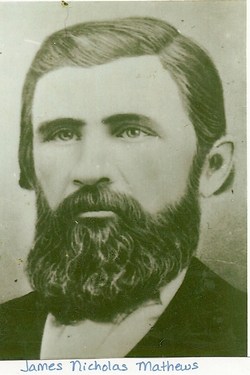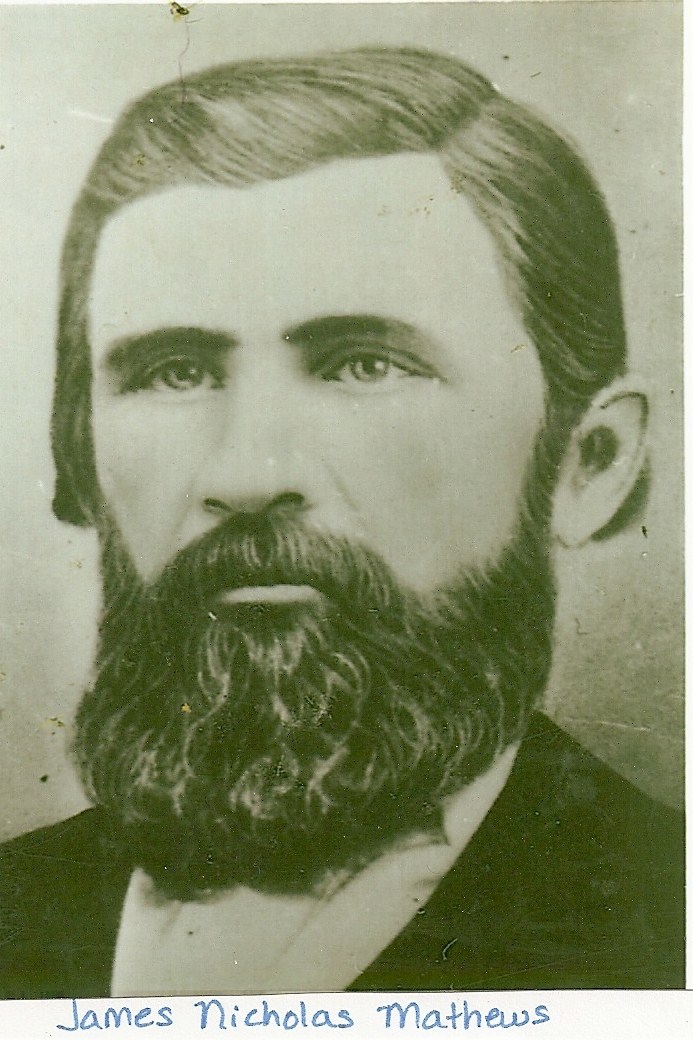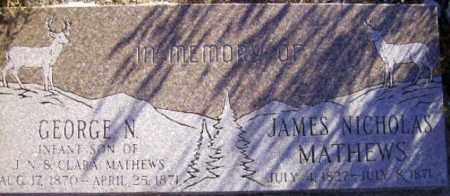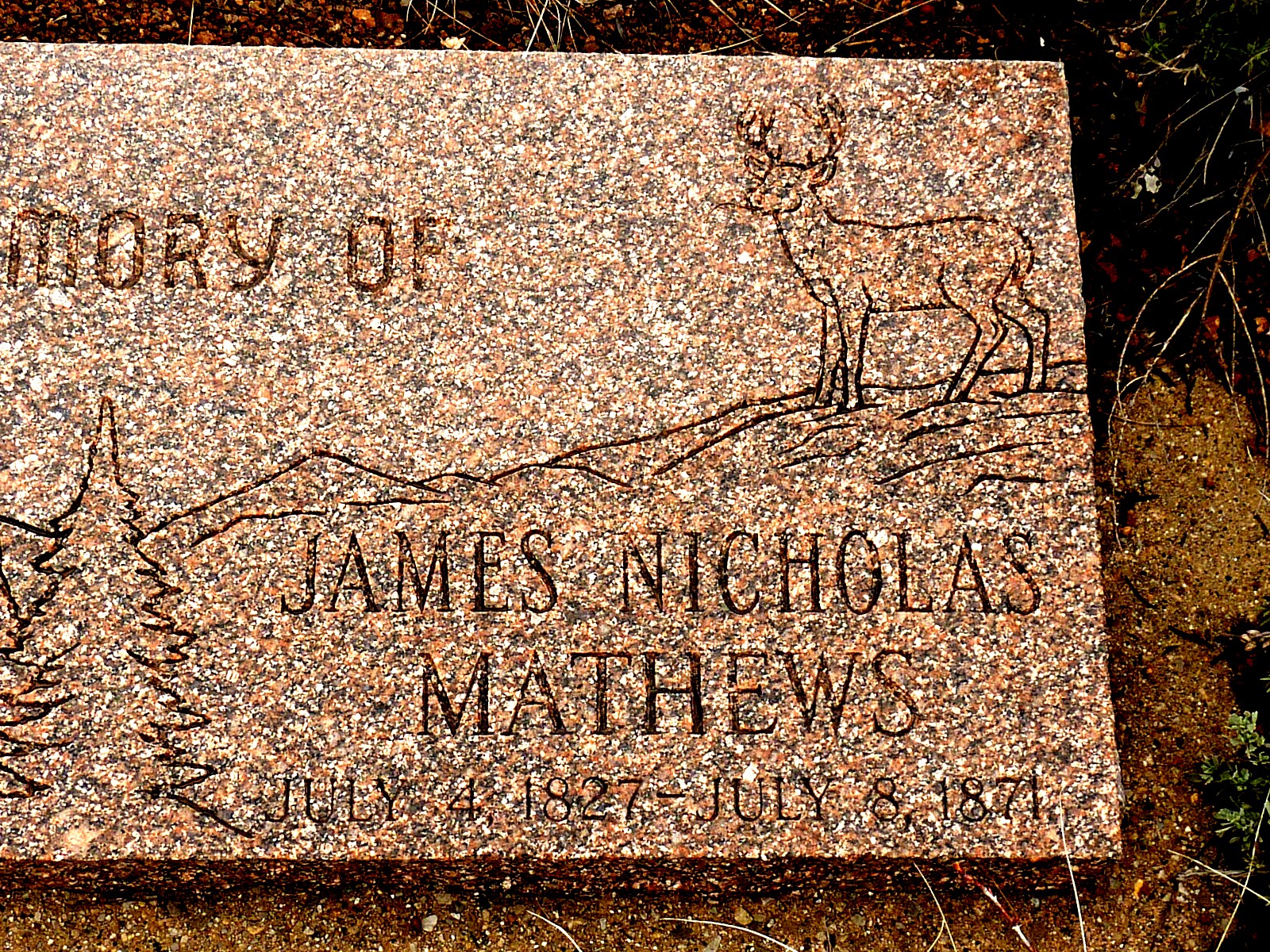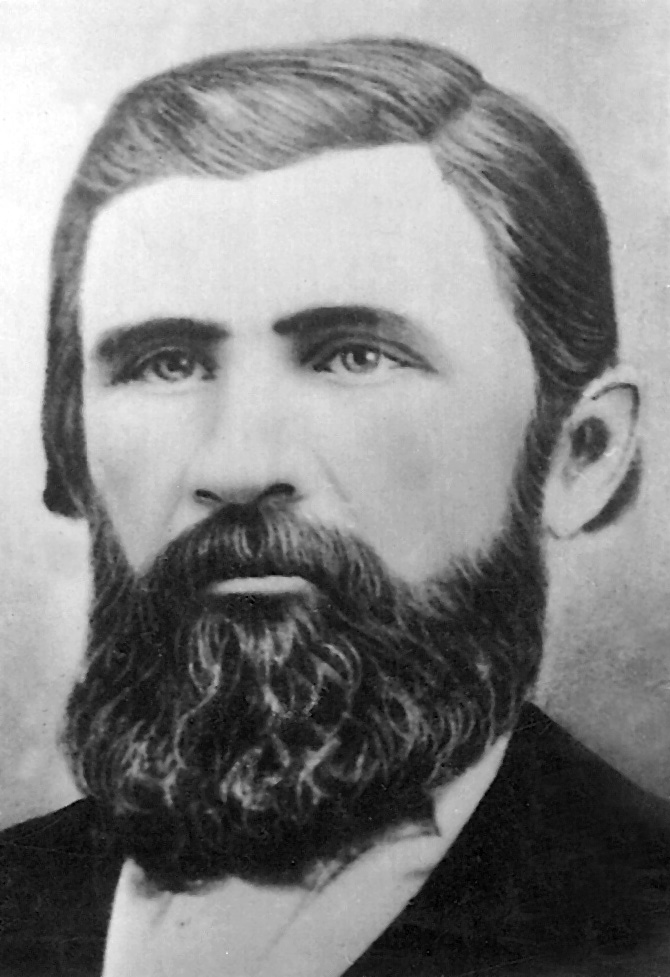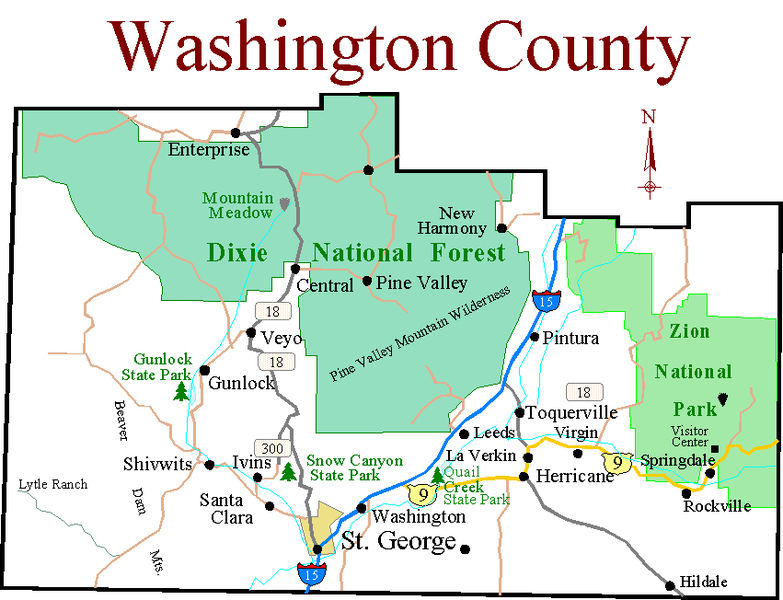Son of Thomas Mathis and Martha Ann Nicholas
Married Clara Elizabeth Slade, abt 1857, Washington, Washington, Utah
Children - James William Mathews, John Mathews, Martha Ann Mathews, Joseph Edward Mathews, Clara Alice Mathews, Hyrum Mathews, Jacob Mathews, Thomas Mathews, Jefferson Albert Mathews, George Mathews
Sketch
James Nicholas Mathews was a native of rural Alabama with American forebears in Kentucky and Alabama. He moved from Alabama to Mississippi, then on to western Illinois. From there he followed the Mormons to frontier Utah. He was an American frontiersman and pioneer of southern Utah.
Early Life In the South
Mathews was born to Knowel and Martha Ann Mathews in Pickens County in west-central Alabama. Those of his America forebears who can be identified were from Kentucky and Alabama. In the early 1830s, they moved across the border to De Kalb, Kemper County in east-central Mississippi, then to Hinds County in central Mississippi. Eventually, they heard the Mormon message and moved to Illinois.
Migration to Utah
After the death of the Mormon leader Joseph Smith in 1844 and the continued unrest between Mormons and the original settlers during 1845-46, the Mormons decided to move farther west. In 1846, James Mathews joined the Mormon exodus from western Illinois to begin the migration to the Great Basin. They sojourned in Iowa Territory that year.
In spring 1847, Mathews joined the Edward Hunter-Jacob Foutz Company, which began its journey in mid-June from the outfitting post on the Elkhorn River several dozen miles west of Winter Quarters, Nebraska Territory. In the Mathews group were James Nicholas, 21, Mary Catherine, 17, and Sarah Ann, 13. One account maintains that Mathews was a small slaveowner who brought at least one slave to Utah, although this cannot be verified from the company roster.
The Mormon Trail
They passed the usual milestones on the trail: Fort Kearney, the South Fork of the Platte River, Chimney Rock, Fort Laramie, the Sweetwater River, Independence Rock, Devil's Gate, Green River, Fort Bridger, Bear River, and Weber River. After suffering the hardships of overland trail, they arrived in the valley of the Great Salt Lake around the first of October.
To San Bernardino, California for a Season
In 1851, Mathews was among the group of southern slaveholders who accompanied Amasa M. Lyman to San Bernardino to establish a Mormon colony there. It is not clear when Mathews returned to Utah. However, like the other southerners in California, they left without their slaves. California was a free state and their slaves were deemed freed. They were not permitted to remove them. (Some of these freed slaves eventually became pillars of the African Methodist Episcopalian (A.M.E.) Church in Los Angeles.)
Joining the Southerners in Washington County and the Cotton Mission
In spring 1857, Mathews was part of a migration of southerners to the new settlement of Washington in Washington County. These southerners founded the Cotton Mission in what came to be known as Utah's Dixie.
Washington appeared to have many advantages over other nearby locales. It was located near several fine springs and the Washington fields seemed to provide a lush expanse of farmland. However, appearances proved to be deceiving and soon "Dixie" was considered one of the most difficult areas to colonize. The broad fields were actually floodplains so if their dams washed out, as they did with discouraging frequency, their crops were jeopardized. Meanwhile the springs, so inviting in an arid, hot country, created marshes, the perfect habitat for mosquitos. Many of them suffered from bouts of malaria (the "fever and ague" or "chills") for many years.
In the same year, thirty-year-old Mathews married fifteen-year-old Clara Elizabeth Slade (1841-1891), of Harris County, Texas, the daughter of William Rufus Slade and Julianne H. Slade. This was a Reformation-era marriage. Also, Mathews was appoint as a constable while his father-in-law was appointed as a Justice of the Peace.
Although the Cotton Mission eventually proved commercially unsuccessful, it did succeed in producing cotton goods for local use and export at an important stage in Utah Territory's economic development.
In the Iron Military District: 2nd Lieutenant James Mathews, Company I, John D. Lee's 4th Battalion
In 1857, the Iron Military District consisted of four battalions led by regimental commander Col. William H. Dame. The platoons and companies in the first battalion drew on men in and around Parowan. (It had no involvement at Mountain Meadows.) Major Isaac Haight commanded the 2nd Battalion whose personnel in its many platoons and two companies came from Cedar City and outer-lying communities to the north such as Fort Johnson. Major John Higbee headed the 3rd Battalion whose many platoons and two companies were drawn from Cedar City and outer-lying communities to the southwest such as Fort Hamilton. Major John D. Lee of Fort Harmony headed the 4th Battalion whose platoons and companies drew on its militia personnel from Fort Harmony, the Southerners at the newly-founded settlement in Washington, the Indian interpreters at Fort Clara, and the new settlers at Pinto.
In September 1857, Mathews was a 2nd Lieutenant of the 2nd platoon in Washington, in Harrison Pearce's Company I, part of John D. Lee's 4th Battalion.
Mathews was probably recruited on Sunday, September 6 and his party moved north on Monday the 7th and met Lee that evening some miles south of Mountain Meadows. The next day they moved up to the Meadows and encamped there in the "southern" encampment.
Mathews specific role during the massacre on Friday the 11th is not known.
Mathews was not named in the 1859 arrest warrant. However, John D. Lee identified him in Mormonism Unveiled," Lee's autobiography published posthumously in 1877.
Later Life
In the early 1860s Mathews and his family moved to Pine Valley in northern Washington County where they remained except for a brief stay near modern-day Panaca in eastern Nevada. His brother-in-law William Slade and family also moved to Pine Valley. Because of its access to the pine forests on Pine Valley Mountain, the settlement began as a lumber camp. Over time lumber mills expanded in number and capacity, both in the canyons and the lower townsite. These mills produced an ever increasing supply of lumber for the needs of the growing communities of southwestern Utah.
In 1864, Mathews and several other families moved to Meadow Valley in modern-day Nevada where they built sod houses and planted wheat. However, Indian unrest at the outset of the Black Hawk War caused these Mormon settlements in Nevada to be quickly abandoned and the Mathews returned to Pine Valley. He pursued farming and grazing livestock. He may have also helped in efforts to maintain the peace with local Indians during the general Ute, Paiute, and Navajo uprisings in the late 1860s. One report mentions Constable James Mathews holding a renegade Indian as a prisoner on orders of Judge John D. Lee in 1868.
Final Years
James N. Mathews continued on at Pine Valley where he died in 1871. He was survived by his wife and five children.
Mormon Pioneer Overland Travel, Edward Hunter - Jacob Foutz Company (1847); Age at departure: 21
Son of Thomas Mathis and Martha Ann Nicholas
Married Clara Elizabeth Slade, abt 1857, Washington, Washington, Utah
Children - James William Mathews, John Mathews, Martha Ann Mathews, Joseph Edward Mathews, Clara Alice Mathews, Hyrum Mathews, Jacob Mathews, Thomas Mathews, Jefferson Albert Mathews, George Mathews
Sketch
James Nicholas Mathews was a native of rural Alabama with American forebears in Kentucky and Alabama. He moved from Alabama to Mississippi, then on to western Illinois. From there he followed the Mormons to frontier Utah. He was an American frontiersman and pioneer of southern Utah.
Early Life In the South
Mathews was born to Knowel and Martha Ann Mathews in Pickens County in west-central Alabama. Those of his America forebears who can be identified were from Kentucky and Alabama. In the early 1830s, they moved across the border to De Kalb, Kemper County in east-central Mississippi, then to Hinds County in central Mississippi. Eventually, they heard the Mormon message and moved to Illinois.
Migration to Utah
After the death of the Mormon leader Joseph Smith in 1844 and the continued unrest between Mormons and the original settlers during 1845-46, the Mormons decided to move farther west. In 1846, James Mathews joined the Mormon exodus from western Illinois to begin the migration to the Great Basin. They sojourned in Iowa Territory that year.
In spring 1847, Mathews joined the Edward Hunter-Jacob Foutz Company, which began its journey in mid-June from the outfitting post on the Elkhorn River several dozen miles west of Winter Quarters, Nebraska Territory. In the Mathews group were James Nicholas, 21, Mary Catherine, 17, and Sarah Ann, 13. One account maintains that Mathews was a small slaveowner who brought at least one slave to Utah, although this cannot be verified from the company roster.
The Mormon Trail
They passed the usual milestones on the trail: Fort Kearney, the South Fork of the Platte River, Chimney Rock, Fort Laramie, the Sweetwater River, Independence Rock, Devil's Gate, Green River, Fort Bridger, Bear River, and Weber River. After suffering the hardships of overland trail, they arrived in the valley of the Great Salt Lake around the first of October.
To San Bernardino, California for a Season
In 1851, Mathews was among the group of southern slaveholders who accompanied Amasa M. Lyman to San Bernardino to establish a Mormon colony there. It is not clear when Mathews returned to Utah. However, like the other southerners in California, they left without their slaves. California was a free state and their slaves were deemed freed. They were not permitted to remove them. (Some of these freed slaves eventually became pillars of the African Methodist Episcopalian (A.M.E.) Church in Los Angeles.)
Joining the Southerners in Washington County and the Cotton Mission
In spring 1857, Mathews was part of a migration of southerners to the new settlement of Washington in Washington County. These southerners founded the Cotton Mission in what came to be known as Utah's Dixie.
Washington appeared to have many advantages over other nearby locales. It was located near several fine springs and the Washington fields seemed to provide a lush expanse of farmland. However, appearances proved to be deceiving and soon "Dixie" was considered one of the most difficult areas to colonize. The broad fields were actually floodplains so if their dams washed out, as they did with discouraging frequency, their crops were jeopardized. Meanwhile the springs, so inviting in an arid, hot country, created marshes, the perfect habitat for mosquitos. Many of them suffered from bouts of malaria (the "fever and ague" or "chills") for many years.
In the same year, thirty-year-old Mathews married fifteen-year-old Clara Elizabeth Slade (1841-1891), of Harris County, Texas, the daughter of William Rufus Slade and Julianne H. Slade. This was a Reformation-era marriage. Also, Mathews was appoint as a constable while his father-in-law was appointed as a Justice of the Peace.
Although the Cotton Mission eventually proved commercially unsuccessful, it did succeed in producing cotton goods for local use and export at an important stage in Utah Territory's economic development.
In the Iron Military District: 2nd Lieutenant James Mathews, Company I, John D. Lee's 4th Battalion
In 1857, the Iron Military District consisted of four battalions led by regimental commander Col. William H. Dame. The platoons and companies in the first battalion drew on men in and around Parowan. (It had no involvement at Mountain Meadows.) Major Isaac Haight commanded the 2nd Battalion whose personnel in its many platoons and two companies came from Cedar City and outer-lying communities to the north such as Fort Johnson. Major John Higbee headed the 3rd Battalion whose many platoons and two companies were drawn from Cedar City and outer-lying communities to the southwest such as Fort Hamilton. Major John D. Lee of Fort Harmony headed the 4th Battalion whose platoons and companies drew on its militia personnel from Fort Harmony, the Southerners at the newly-founded settlement in Washington, the Indian interpreters at Fort Clara, and the new settlers at Pinto.
In September 1857, Mathews was a 2nd Lieutenant of the 2nd platoon in Washington, in Harrison Pearce's Company I, part of John D. Lee's 4th Battalion.
Mathews was probably recruited on Sunday, September 6 and his party moved north on Monday the 7th and met Lee that evening some miles south of Mountain Meadows. The next day they moved up to the Meadows and encamped there in the "southern" encampment.
Mathews specific role during the massacre on Friday the 11th is not known.
Mathews was not named in the 1859 arrest warrant. However, John D. Lee identified him in Mormonism Unveiled," Lee's autobiography published posthumously in 1877.
Later Life
In the early 1860s Mathews and his family moved to Pine Valley in northern Washington County where they remained except for a brief stay near modern-day Panaca in eastern Nevada. His brother-in-law William Slade and family also moved to Pine Valley. Because of its access to the pine forests on Pine Valley Mountain, the settlement began as a lumber camp. Over time lumber mills expanded in number and capacity, both in the canyons and the lower townsite. These mills produced an ever increasing supply of lumber for the needs of the growing communities of southwestern Utah.
In 1864, Mathews and several other families moved to Meadow Valley in modern-day Nevada where they built sod houses and planted wheat. However, Indian unrest at the outset of the Black Hawk War caused these Mormon settlements in Nevada to be quickly abandoned and the Mathews returned to Pine Valley. He pursued farming and grazing livestock. He may have also helped in efforts to maintain the peace with local Indians during the general Ute, Paiute, and Navajo uprisings in the late 1860s. One report mentions Constable James Mathews holding a renegade Indian as a prisoner on orders of Judge John D. Lee in 1868.
Final Years
James N. Mathews continued on at Pine Valley where he died in 1871. He was survived by his wife and five children.
Mormon Pioneer Overland Travel, Edward Hunter - Jacob Foutz Company (1847); Age at departure: 21
Family Members
Advertisement
Explore more
Sponsored by Ancestry
Advertisement
